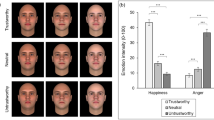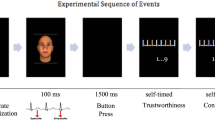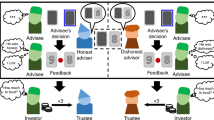Abstract
Successful social interaction partly depends on appraisal of others from their facial appearance. A critical aspect of this appraisal relates to whether we consider others to be trustworthy. We determined the neural basis for such trustworthiness judgments using event-related functional magnetic resonance imaging. Subjects viewed faces and assessed either trustworthiness or age. In a parametric factorial design, trustworthiness ratings were correlated with BOLD signal change to reveal task-independent increased activity in bilateral amygdala and right insula in response to faces judged untrustworthy. Right superior temporal sulcus (STS) showed enhanced signal change during explicit trustworthiness judgments alone. The findings extend a proposed model of social cognition by highlighting a functional dissociation between automatic engagement of amygdala versus intentional engagement of STS in social judgment.
This is a preview of subscription content, access via your institution
Access options
Subscribe to this journal
Receive 12 print issues and online access
$209.00 per year
only $17.42 per issue
Buy this article
- Purchase on Springer Link
- Instant access to full article PDF
Prices may be subject to local taxes which are calculated during checkout





Similar content being viewed by others
References
Humphrey, N. Consciousness Regained: Chapters in the Development of Mind (Oxford Univ. Press, New York, 1983).
Adolphs, R., Tranel, D., Damasio, H. & Damasio, A. Impaired recognition of emotion in facial expressions following bilateral damage to the human amygdala. Nature 372, 669–672 (1994).
Hornak, J., Rolls, E. T. & Wade, D. Face and voice expression identification in patients with emotional and behavioural changes following ventral frontal lobe damage. Neuropsychologia 34, 247–261 (1996).
Adolphs, R., Damasio, H., Tranel, D., Cooper, G. & Damasio, A. R. A role for somatosensory cortices in the visual recognition of emotion as revealed by three-dimensional lesion mapping. J. Neurosci. 20, 2683–2690 (2000).
Morris, J. S. et al. A differential neural response in the human amygdala to fearful and happy facial expressions. Nature 383, 812–815 (1996).
Phillips, M. L. et al. A specific neural substrate for perceiving facial expressions of disgust. Nature 389, 495–498 (1997).
Sprengelmeyer, R., Rausch, M., Eysel, U. T. & Przuntek, H. Neural structures associated with recognition of facial expressions of basic emotions. Proc. R. Soc. Lond. B Biol. Sci. 265, 1927–1931 (1998).
Adolphs, R., Tranel, D. & Damasio, A. R. The human amygdala in social judgment. Nature 393, 470–474 (1998).
Eslinger, P. J. & Damasio, A. R. Severe disturbance of higher cognition after bilateral frontal lobe ablation: patient EVR. Neurology 35, 1731–1741 (1985).
Damasio, A. R. Descartes' Error: Emotion, Reason and the Human Brain (Putnam, New York, 1994).
Brothers, L. The social brain: a project for integrating primate behavior and neurophysiology in a new domain. Concepts Neurosci. 1, 27–51 (1990).
Adolphs, R. Social cognition and the human brain. Trends. Cogn. Sci. 3, 469–479 (1999).
Adolphs, R. The neurobiology of social cognition. Curr. Opin. Neurobiol. 11, 231–239 (2001).
Allison, T., Puce, A. & McCarthy, G. Social perception from visual cues: role of the STS region. Trends Cogn. Sci. 4, 267–278 (2000).
Dolan, R. J. et al. Neural activation during covert processing of positive emotional facial expressions. Neuroimage 4, 194–200 (1996).
Blair, R. J., Morris, J. S., Frith, C. D., Perrett, D. I. & Dolan, R. J. Dissociable neural responses to facial expressions of sadness and anger. Brain 122, 883–893 (1999).
Lane, R. D., Chau, P. M. & Dolan, R. J. Common effects of emotional valence, arousal and attention on neural activation during visual processing of pictures. Neuropsychologia 37, 989–997 (1999).
Morris, J. S., Ohman, A. & Dolan, R. J. Conscious and unconscious emotional learning in the human amygdala. Nature 393, 467–470 (1998).
Whalen, P. J. et al. Masked presentations of emotional facial expressions modulate amygdala activity without explicit knowledge. J. Neurosci. 18, 411–418 (1998).
Strange, B. A., Henson, R. N., Friston, K. J. & Dolan, R. J. Brain mechanisms for detecting perceptual, semantic, and emotional deviance. Neuroimage 12, 425–433 (2000).
Vuilleumier, P., Armony, J. L., Driver, J. & Dolan, R. J. Effects of attention and emotion on face processing in the human brain. An event-related fMRI study. Neuron 30, 829–841 (2001).
Buechel, C., Morris, J., Dolan, R. J. & Friston, K. J. Brain systems mediating aversive conditioning: an event-related fMRI study. Neuron 20, 947–957 (1998).
Buechel, C., Dolan, R. J., Armony, J. L. & Friston, K. J. Amygdala-hippocampal involvement in human aversive trace conditioning revealed through event-related functional magnetic resonance imaging. J. Neurosci. 19, 10869–10876 (1999).
Casey, K. L. Forebrain mechanisms of nociception and pain: analysis through imaging. Proc. Natl. Acad. Sci. USA 96, 7668–7674 (1999).
Critchley, H. D., Mathias, C. J. & Dolan, R. J. Neural activity in the human brain relating to uncertainty and arousal during anticipation. Neuron 29, 537–545 (2001).
Damasio, A. The Feeling of What Happens: Body and Emotion in the Making of Consciousness (Harcourt Brace, New York, 1999).
Critchley, H. D., Mathias, C. J. & Dolan, R. J. Neuroanatomical basis for first- and second-order representations of bodily states. Nat. Neurosci. 4, 207–212 (2001).
Breiter, H. C. et al. Response and habituation of the human amygdala during visual processing of facial expression. Neuron 17, 875–887 (1996).
Isenberg, N. et al. Linguistic threat activates the human amygdala. Proc. Natl. Acad. Sci. USA 96, 10456–10459 (1999).
Morris, J. S., Buchel, C. & Dolan, R. J. Parallel neural responses in amygdala subregions and sensory cortex during implicit fear conditioning. Neuroimage 13, 1044–1052 (2001).
Dolan, R. J., Morris, J. S. & de Gelder, B. Crossmodal binding of fear in voice and face. Proc. Natl. Acad. Sci. USA 98, 10006–10010 (2001).
Morris, J. S. et al. A neuromodulatory role for the human amygdala in processing emotional facial expressions. Brain 121, 47–57 (1998).
Amaral, D. G. & Price, J. L. Amygdalo-cortical projections in the monkey (Macaca fascicularis). J. Comp. Neurol. 230, 465–496 (1984).
Anderson, A. K. & Phelps, E. A. Lesions of the human amygdala impair enhanced perception of emotionally salient events. Nature 411, 305–309 (2001).
Bonda, E., Petrides, M., Ostry, D. & Evans, A. Specific involvement of human parietal systems and the amygdala in the perception of biological motion. J. Neurosci. 16, 3737–3744 (1996).
Castelli, F., Happe, F., Frith, U. & Frith, C. Movement and mind: a functional imaging study of perception and interpretation of complex intentional movement patterns. Neuroimage 12, 314–325 (2000).
Fletcher, P. C. et al. Other minds in the brain: a functional imaging study of 'theory of mind' in story comprehension. Cognition 57, 109–128 (1995).
Gallagher, H. L. et al. Reading the mind in cartoons and stories: an fMRI study of 'theory of mind' in verbal and nonverbal tasks. Neuropsychologia 38, 11–21 (2000).
Brunet, E., Sarfati, Y., Hardy-Bayle, M. C. & Decety, J. A PET investigation of the attribution of intentions with a nonverbal task. Neuroimage 11, 157–166 (2000).
Frith, C. D. & Frith, U. Interacting minds—a biological basis. Science 286, 1692–1695 (1999).
Frith, C. & Frith, U. in Understanding Other Minds: Perspectives From Developmental Cognitive Neuroscience (eds. Baron-Cohen, S., Tager-Flusberg, H. & Cohen, D. J.) 334–356 (Oxford Univ. Press, New York, 2000).
Elliott, R. & Dolan, R. J. Neural response during preference and memory judgments for subliminally presented stimuli: a functional neuroimaging study. J. Neurosci. 18, 4697–4704 (1998).
Phillips, M. L. et al. Neural responses to facial and vocal expressions of fear and disgust. Proc. R. Soc. Lond. B Biol. Sci. 265, 1809–1817 (1998).
Friston, K. et al. Spatial registration and normalization of images. Hum. Brain Mapp. 2, 165–189 (1995).
Talairach, J. & Tournoux, P. Co-planar Stereotaxic Atlas of the Human Brain (Theime, Stuttgart, Germany, 1988).
Ekman, P. & Friesen, W. V. Pictures of Facial Affect (Consulting Psychologists Press, Palo Alto, California, 1975).
Josephs, O., Turner, R. & Friston, K. Event-related fMRI. Hum. Brain Mapp. 5, 243–248 (1997).
Friston, K. et al. Statistical parametric maps in functional imaging: a general linear approach. Hum. Brain Mapp. 2, 189–210 (1995).
Worsley, K. et al. A unified statistical approach for determining significant signals in images of cerebral activation. Hum. Brain Mapp. 4, 58–73 (1996).
Duvernoy, H. M. The Human Brain (Springer, Vienna, 1999).
Acknowledgements
This work was supported by a programme grant to R.J.D. from the Wellcome Trust.
Author information
Authors and Affiliations
Corresponding author
Ethics declarations
Competing interests
The authors declare no competing financial interests.
Rights and permissions
About this article
Cite this article
Winston, J., Strange, B., O'Doherty, J. et al. Automatic and intentional brain responses during evaluation of trustworthiness of faces. Nat Neurosci 5, 277–283 (2002). https://doi.org/10.1038/nn816
Received:
Accepted:
Published:
Issue Date:
DOI: https://doi.org/10.1038/nn816
This article is cited by
-
The neuroanatomy of social trust predicts depression vulnerability
Scientific Reports (2022)
-
Age differences in facial trustworthiness perception are diminished by affective processing
European Journal of Ageing (2022)
-
The impact of facemasks on emotion recognition, trust attribution and re-identification
Scientific Reports (2021)
-
Effectiveness of the level of personal relevance of visual autobiographical stimuli in the induction of positive emotions in young and older adults: pilot study protocol for a randomized controlled trial
Trials (2020)
-
Effects of PM2.5 and gases exposure during prenatal and early-life on autism–like phenotypes in male rat offspring
Particle and Fibre Toxicology (2020)



